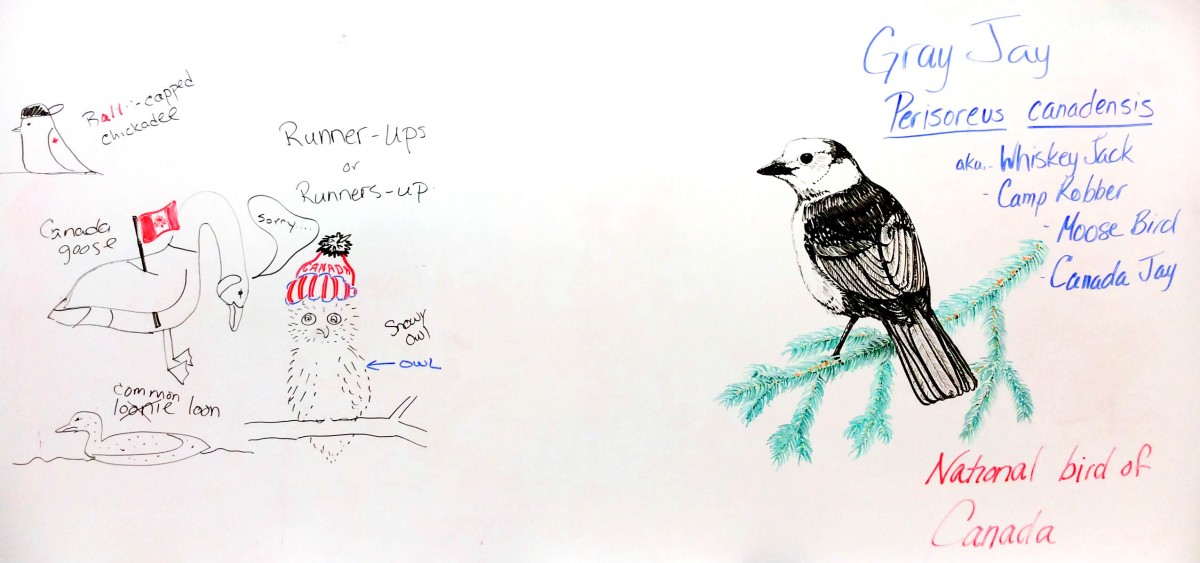
Drawings by biology faculty member Stephen Joly are sketched on a whiteboard in the Faculty of Science break room.
A small bird with an unassuming appearance, a persistent personality, who lives in every province and territory and sounds at times like a chattering monkey, has been named the country’s national bird by Canadian Geographic magazine.
Let’s hear it for the gray jay, also known as the Canada jay, whiskey jack and camp robber.
The magazine came up with the idea of a national bird as a way of celebrating 2017 being Canada’s 150th birthday. The online voting recently closed and the judges announced the gray jay, which beat out better-known birds the likes of the Canada goose, snowy owl and the common loon.
For some commentary on the decision, we turn to three of TRU’s bird experts—Dean of Science Tom Dickinson and faculty members Nancy Flood and Stephen Joly.
They agree the choice is a good one for numerous reasons and following are a few that may make you smile.
Living in Canada means living with the cold
Flood: “They are hardcore Canadians because they don’t escape to warmer climes in the winter, but tough it out by surviving partly on food they’ve cached during the summer. An individual gray jay can store hundreds of seeds in various places during a single day in the summer and remember where enough of the caches are months later. They harvest and store food up for the long winter ahead. How Canadian is that?”
Dickinson: “They not only endure, but thrive in our snowy winters and they do this by using their wits and their physical fortitude. They nest at the end of winter and I’ve watched a fluffed-out mother sit tight on eggs in the middle of a snowstorm in Algonquin Park.
Older siblings help around the home
Flood: “Often young from the previous year will help older adults (typically their own parents) feed the young from that year, but only after those young have left the nest and are still hanging around being fed and learning the ropes of survival. The young adults get to watch how to build a nest, learn how to detect predators, learn to care for the younger ones and to find food by retrieving caches to feed the younger ones. How great is that?”
Guard your grub
Dickinson: “They need to be food-motivated to get enough energy to survive the coldest of nights, and so become fearless when a food source is found. They will out-compete ravens for frozen carrion, or compete with me for my trail mix at my campsite.”
Flood: “My favourite recollection of gray jays is seeing the delight of my then-young children as they had the birds come to their hands to take seeds while we were hiking in Wells Gray Park. They are feisty and smart birds—brave enough to visit campsites and smart enough to steal food that isn’t being watched. But, they aren’t terribly aggressive about it—like most Canadians. They are polite and friendly and will land on a hand holding food if the person is patient.”
Joly: “In 2013 while on a field ornithology trip, we made a stop at Lightning Lake in Manning Park and as we looked at the still frozen lake, a small flock of gray jays approached the group. Students were amazed at how they came right down to their hand to take the Goldfish Crackers we were offering. I then turned to the class and said, “Watch this,” and held a cracker in my lips. Within a few seconds a gray jay flew down, landed on my chin, and made off with the cracker.”
Dressed for success
Dickinson: “They are very handsome birds and when I see an adult, I think of him or her as being dressed for an elegant formal occasion in a white shirt and an ashy-gray tuxedo or gown. They move with grace on the wing, with flutters and glides. Very classy, but unpretentious. How much more Canadian can you get?”
Humble citizens
Joly: “Their non-garish plumage speaks to us Canadians as having a collectively humble personality.”
Learn something new?
Flood: “A final reason for the gray jay? The bird seems to be unfamiliar to many Canadians and because of that, could be the impetus to learn something new.”
Now that’s something worth tweeting about.

